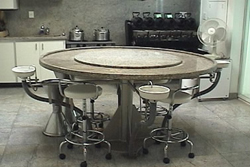
Coffee cupping, or coffee tasting, is the practice of observing the tastes and aromas of brewed coffee. It is a professional practise but can be done informally by anyone or by professionals known as Master Tasters. A standard coffee cupping procedure involves deeply sniffing the coffee, then loudly slurping the coffee so it spreads to the back of the tongue. The coffee taster attempts to measure aspects of the coffee's taste, specifically the body (the texture or mouthfeel, such as oiliness), acidity (a sharp and tangy feeling, like when biting into an orange), and balance (the harmony of flavours working together). Since coffee beans embody telltale flavours from the region where they were grown, cuppers may attempt to predict the coffee's origin.

In a coffee cupping session, the table is usually set up with 6 to 10 cups per coffee. These are fashioned in a triangular manner. At the top of this triangle you should place a sample of the roasted coffee and a sample of the green coffee. In the center of the table place a cup of room temperature water and an empty cup containing the cupping spoons. Cover both the green sample and roasted sample until the cupping session is over and the coffee aroma, fragrance, and flavor profile have been documented. After this time, the coffee samples could be uncovered and additional comments can be written based on appearance. This method will help reduce the common "eye cupping" technique.
To prepare the coffee samples, place 2 tablespoons of freshly roasted and freshly ground coffee in a 6 oz cup. Ideally one should use 55g of coffee per liter of water. The grind should be between a French press size and a drip coffee size. The coffee should be roasted light (Agtron 65). In the industry we often stop the roast about 30 seconds into the first crack long before the start of the second crack. This allows us to fully evaluate the coffee for defects and for the sweetness and aroma that are burned off at darker roasts. The roast should be similar for all of the coffees evaluated. During an important coffee cupping session the roast similarity can be verified visually by grinding a portion of each sample and lining the coffee samples up next to each other on a black sheet of paper.
Information and Image Source: Coffee Research
Cupping
Aroma Analysis | Aroma Types | Flavor Analysis | Taste Wheel
Roasting
Roasting | Drying Process | Flavor Characteristics of Drying Process
Sorting |
Polishing and Aging | Decaffeination Processes

















































